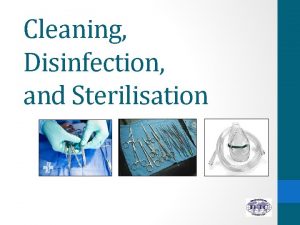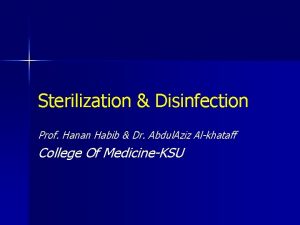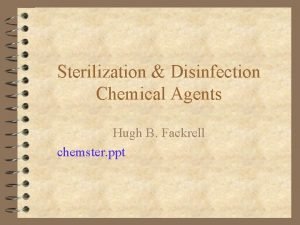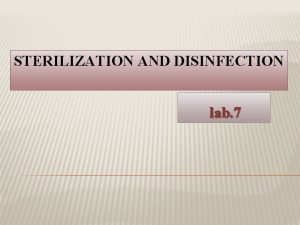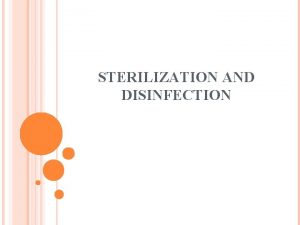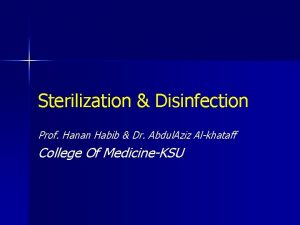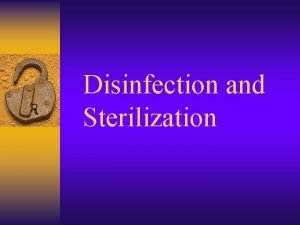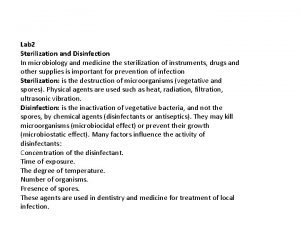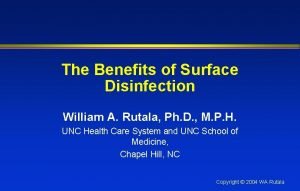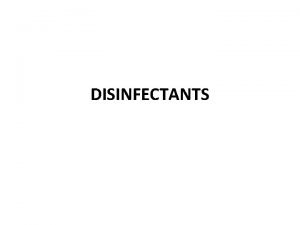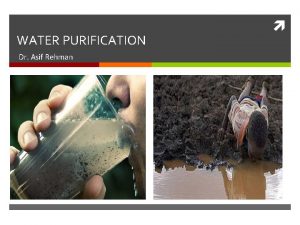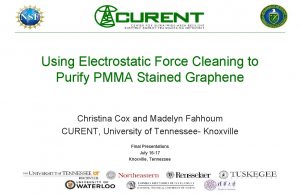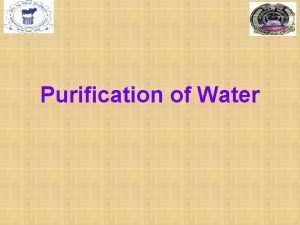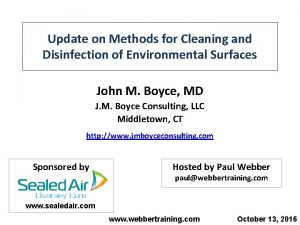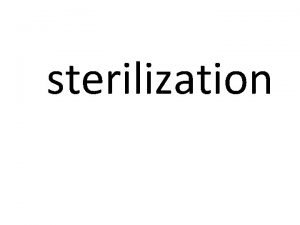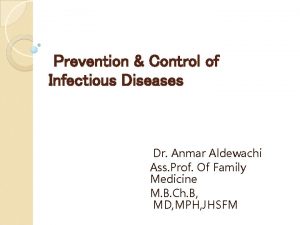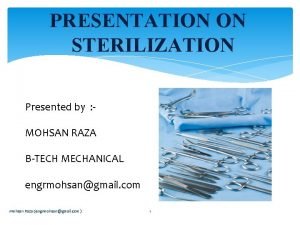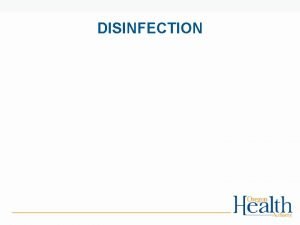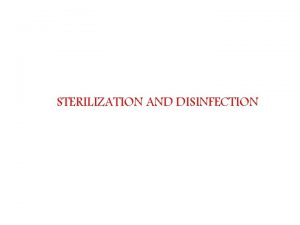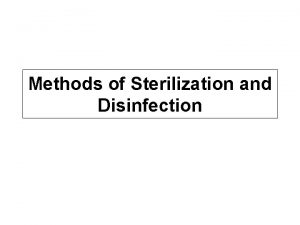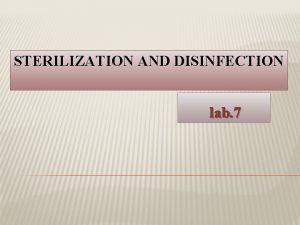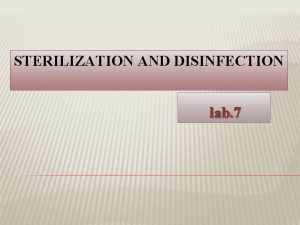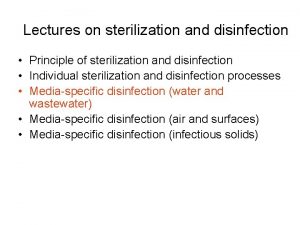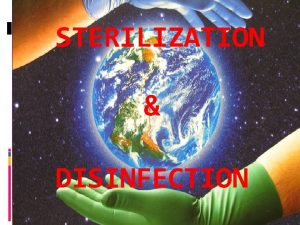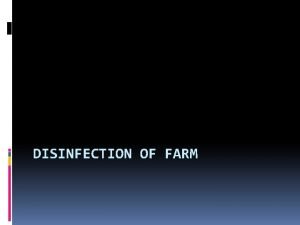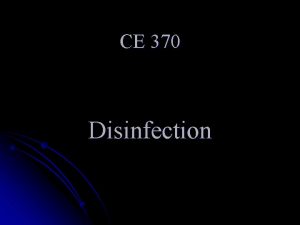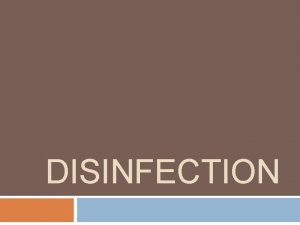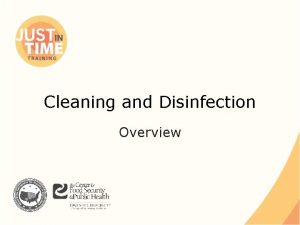Sterilization and Disinfection Definition Sterilization means destruction of



















- Slides: 19

Sterilization and Disinfection

Definition • Sterilization means destruction of all microorganisms including spores • Disinfection means the destruction of vegetative organisms which might cause disease or putrefaction • Sterilization Methods • Red heat (Flaming) • Dry heat (Hot air) • Moist heat • Steam under pressure (autoclaving) • Steam not under pressure (Tyndallization) • Filtration

Dry Heat • Instruments inoculating wires and loops are sterilized by in a flame • Incineration • Glass spreaders, forceps, scissors to flaming after dipping in alcohol allowing the alcohol to flame • The sterilizing effect of dry heat is due to oxidation of intracellular components and extreme dehydration • very high temperature • glass petridishes, pipettes, flasks and metal objects in hot air oven

• operation or use of hot air oven includes, the heating up period • the holding period 1 h at 160 o C or 2 hours at 140 o C • the cooling down period - to be cooled to less than 80 o C

Moist Heat • The sterilizing effect of moist heat is due to coagulation of proteins • Steam under pressure • Done by autoclaving at 121 o. C for 15 min • suitable for culture media, aqueous solution, treatment of discarded cultures and specimens • Boiling point of water increases with increasing pressure of steam Steam pressure (psi) 0 5 10 15 Temperature 100 o C 109 o C 115 o C 121 o C

Laboratory autoclaves • Pressure cooker type • Gravity displacement

Steam not under pressure (at 100 o. C) • • Moist heat at 100 o. C Arnold’s steam sterilizer Tyndallization is performed at 100 o. C for 20 – 30 min for three successive days Moist heat below 100 o. C (Pasteurization) Not a sterilization method Pasteurization is adopted in preserving milk intended to destroy the vegetative pathogenic organisms – Holder method – Flash method

Filtration • Bacteria can be removed from liquids by passing them through filters • Useful for sterilizing heat labile fluids like vitamins, antibiotics, sera, urea, protein solution etc • Types of filters – Earthernware candle filters - eg. Berkefeld filter, Chamberland filter – Asbestos pad filters - eg. Seitz filters – Sintered glass filter – Membrane filters • made from cellulose acetate or cellulose nitrate • membranes of 0. 45 µ m or 0. 22 µ m are used

Radiation • Many forms of electromagnetic radiation are harmful to microorganisms • Gamma rays and x-rays are more energetic than visible light or infra-red waves • Radiation is the emission and propagation of energy through a space or material medium • Two types – Ionising radiation – Non ionising radiation

– X-rays – γ (gamma) rays • Destruction of DNA is the most important cause of death of organisms

Ultra – violet (UV) radiation • UV has maximum bactericidal effect or is lethal at a wave length of 260 nm • Primary mechanism of UV damage is the formation of thymine dimers in DNA • Killing is appreciable at 330 nm and below • Sterilization using radiation is called cold sterilization

Other methods • Photodynamic sensitization – presence of certain fluorescent dyes, strong visible light denatures proteins and sterilizes bacteria and viruses • Ultrasonic and Sonic waves – ultrasonic range (frequency of 15, 000 hz & more) sound waves denature proteins • Freezing – crystallization of the water results in the formation of tiny pockets of concentrated solution of salts – damage the bacteria

Chemical sterilization • Ethylene oxide (Et. O) • Used for sterilization of plasticwares, tubings, etc • Et. O at the concentration of 700 mg / lit for 5 to 8 hours at 38 o. C or 3 to 4 hours at 54 o. C • Excessive aerations is required after the treatment • Betapropiolactone (BPL), vapour phase of H 2 O 2

Disinfection • Most disinfectants are effective against vegetative bacteria but not spores • While selecting disinfectants, factors such as their toxicity and harmful effects on the skin, eyes and respiratory tract should be considered • Desirable properties of a disinfectant • Effective and capable of rapidly killing microorganisms • Reasonably stable • Non-corrosive and non-staining • Odourless or have an inoffensive odour • Non toxic and non-irritating to skin and eyes • Readily soluble in water and readily rinsable • Cost – effective

Commonly used Disinfectants • Clear phenolics • Effective against bacteria and fungi, inactive against spores • 2 – 5% solutions are recommended • Hypochlorites • activity is due to chlorine and is effective against bacteria, spores • Reasonably clean surfaces – 1000 ppm • Pipette and discard jars - 2500 ppm

• • Aldehydes Formaldehyde, glutaraldehyde Formalin is diluted to 1: 10 Aldehydes are however toxic and cause eye and skin irritation • Alcohol and Alcoholic mixtures • Ethanol and propanol at 70 – 80% concentrations are effective • 10% fomalin in 70% alcohol or 2000 ppm of available chlorine in alcohol is effective

• QAC (Quarternary Ammonium Compounds) • cationic detergents effective against vegetative bacteria, fungi, 1 – 2% dilutions • Iodophores • Iodines are effective vegetative bacteria, spores, fungi, virus • at 75 – 150 ppm iodine

Chemical Disinfectants Agent Halogens Mode of Action Oxidation of proteins and enzymes Chlorine and its compounds Protein inactivation by iodination Iodine and iodophores Heavy metals Mercuric chloride and organomercurials Silver nitrate Phenolic compounds Enzyme inactivation by coupling to sulphydryl groups of proteins Denaturation of proteins and enzymes Disruption of cell membrane, inactivation of proteins and enzymes

Alcohols Solubilization of lipids, denaturation of proteins and inactivation of enzymes Quarternary Ammonium compounds Formaldehyde Disruption of cell membranes; denaturation of proteins and inactivation of enzymes Elthylene oxide Inactivates enzymes Strong reducing agent, inactivates enzymes
 Differentiate between disinfection and sterilization
Differentiate between disinfection and sterilization Sterilization and disinfection
Sterilization and disinfection Sterilization and disinfection
Sterilization and disinfection Sterilization and disinfection
Sterilization and disinfection Tyndallization
Tyndallization Role of nurse in sterilization and disinfection
Role of nurse in sterilization and disinfection Sterilization and disinfection
Sterilization and disinfection Low level disinfectant
Low level disinfectant Sterilization and disinfection in microbiology lab
Sterilization and disinfection in microbiology lab Rutala
Rutala Difference between concurrent and terminal disinfection
Difference between concurrent and terminal disinfection Small scale purification of water
Small scale purification of water Electrostatic disinfection chelsea
Electrostatic disinfection chelsea Zoogleal layer
Zoogleal layer Dry mist disinfection machine
Dry mist disinfection machine What is sterilization
What is sterilization Terminal disinfection ppt
Terminal disinfection ppt Gmail
Gmail Supragingival plaque
Supragingival plaque What is sterilization
What is sterilization
